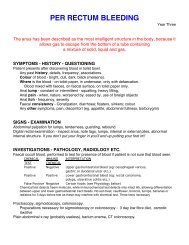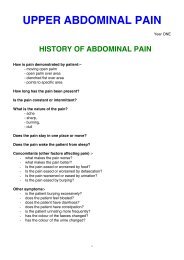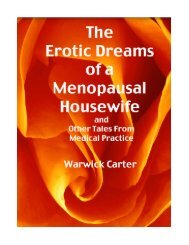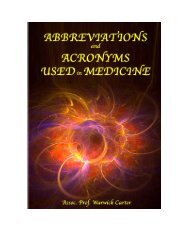Menopause A to Z.pdf - Medwords.com.au
Menopause A to Z.pdf - Medwords.com.au
Menopause A to Z.pdf - Medwords.com.au
You also want an ePaper? Increase the reach of your titles
YUMPU automatically turns print PDFs into web optimized ePapers that Google loves.
MENOPAUSE A <strong>to</strong> Z<br />
gland can be performed through the nose, as the pituitary gland rests on <strong>to</strong>p of the nasal cavity.<br />
The pituitary not only has its own activity but also regulates the activity of other glands, acting as the conduc<strong>to</strong>r of<br />
the endocrine (gland) orchestra. It is no bigger than the size of a walnut. In <strong>to</strong>tal the pituitary gland produces nine<br />
different hormones.<br />
The human growth hormone is one of<br />
these hormones and possibly the most<br />
important. If <strong>to</strong>o little of this hormone is<br />
produced during childhood, the child's<br />
growth will be stunted and it will be a<br />
dwarf. If <strong>to</strong>o much is produced, the child<br />
will grow <strong>to</strong> an abnormal size.<br />
Other hormones stimulate the thyroid<br />
gland and the adrenal glands.<br />
Antidiuretic hormone again acts on the<br />
kidneys and regulates the balance of<br />
water and salts in body fluids.<br />
The follicle stimulating hormone tells<br />
the female ovaries and the male testicles<br />
when <strong>to</strong> produce oestrogen and<br />
tes<strong>to</strong>sterone, and the hormone prolactin<br />
stimulates the manufacture of milk in nursing mothers and controls the menstrual cycle.<br />
At the end of pregnancy when the time <strong>com</strong>es for the child <strong>to</strong> be born, the pituitary stimulates the muscles in the<br />
uterus <strong>to</strong> contract and start labour.<br />
Adrenocorticotrophic hormone (ACTH) controls the activity of the outer part of the adrenal glands, which sit on <strong>to</strong>p of<br />
each kidney.<br />
Melanocyte stimulating hormone (MSH) is produced in the anterior part of the pituitary gland and stimulates<br />
melanocytes (skin pigment cells) <strong>to</strong> produce the black coloured melanin that gives darker colours <strong>to</strong> skin and hair.<br />
The direct connection of the pituitary gland, and through it the other endocrine glands, <strong>to</strong> the brain and thus the<br />
nervous system is the reason why our mental and emotional states can influence our hormone levels and vice versa. If<br />
the pituitary gland malfunctions, the effects can obviously be wide-ranging bec<strong>au</strong>se of the gland's importance in so<br />
many parts of the body.<br />
See also HORMONES<br />
POSTMENOPAUSAL VAGINITIS<br />
See ATROPHIC VAGINITIS<br />
PREMATURE MENOPAUSE<br />
See PREMATURE OVARIAN FAILURE<br />
PREMATURE OVARIAN FAILURE<br />
One in every one hundred women suffers from premature ovarian failure, a condition in which the ovary ceases <strong>to</strong><br />
function normally at a far earlier age than expected. It is really an onset of the menop<strong>au</strong>se at an early age, usually<br />
defined as before 40 years of age. One in very thousand women has premature ovarian failure before the age of 30<br />
years.<br />
Bec<strong>au</strong>se many women are now delaying pregnancy until their career is established, premature ovarian failure is<br />
be<strong>com</strong>ing a steadily more significant problem in the <strong>com</strong>munity.<br />
Affected women cease their periods and are unable <strong>to</strong> fall pregnant. They may start <strong>to</strong> lose some of their feminine<br />
characteristics as the breasts sag and pubic hair be<strong>com</strong>es sparse.<br />
There are usually no warning signs of a premature menop<strong>au</strong>se, and the first a woman knows about it is when her<br />
periods cease. The most <strong>com</strong>mon time for the problem <strong>to</strong> occur is actually after a pregnancy, abortion or miscarriage<br />
when the menstrual periods fail <strong>to</strong> restart. There is a family tendency though, so it may be able <strong>to</strong> judge the risks of<br />
premature ovarian failure by the experience of older sisters or the woman’s mother.<br />
To refer <strong>to</strong> premature ovarian failure as premature menop<strong>au</strong>se is not strictly correct, as more than half of these<br />
women still have eggs (ova) in their ovaries at the time the condition is diagnosed, but the mechanism for the<br />
maturation and release of these eggs is f<strong>au</strong>lty.<br />
There is no specific c<strong>au</strong>se for the condition in most cases although in some cases there is an obvious c<strong>au</strong>se such<br />
as chemotherapy or irradiation for pelvic cancer, and surgery or injury <strong>to</strong> the pelvis that damages the ovaries. Rare<br />
c<strong>au</strong>ses of premature ovarian failure include the disease galac<strong>to</strong>saemia, severe pelvic infections, some <strong>au</strong><strong>to</strong>immune<br />
diseases (eg. Addison disease, myasthenia gravis), severe diabetes, thyroid disease and a number of rare syndromes.<br />
41









